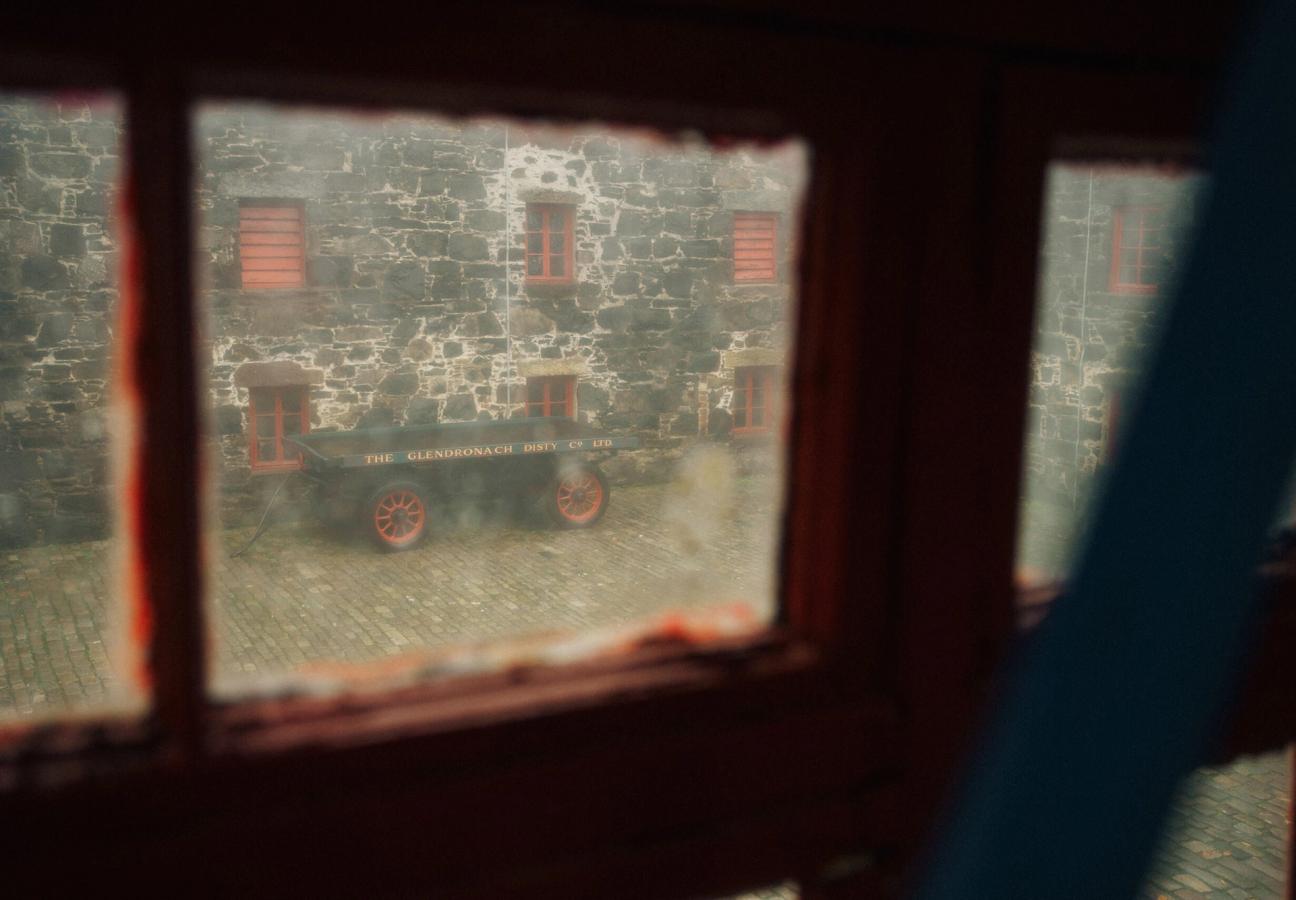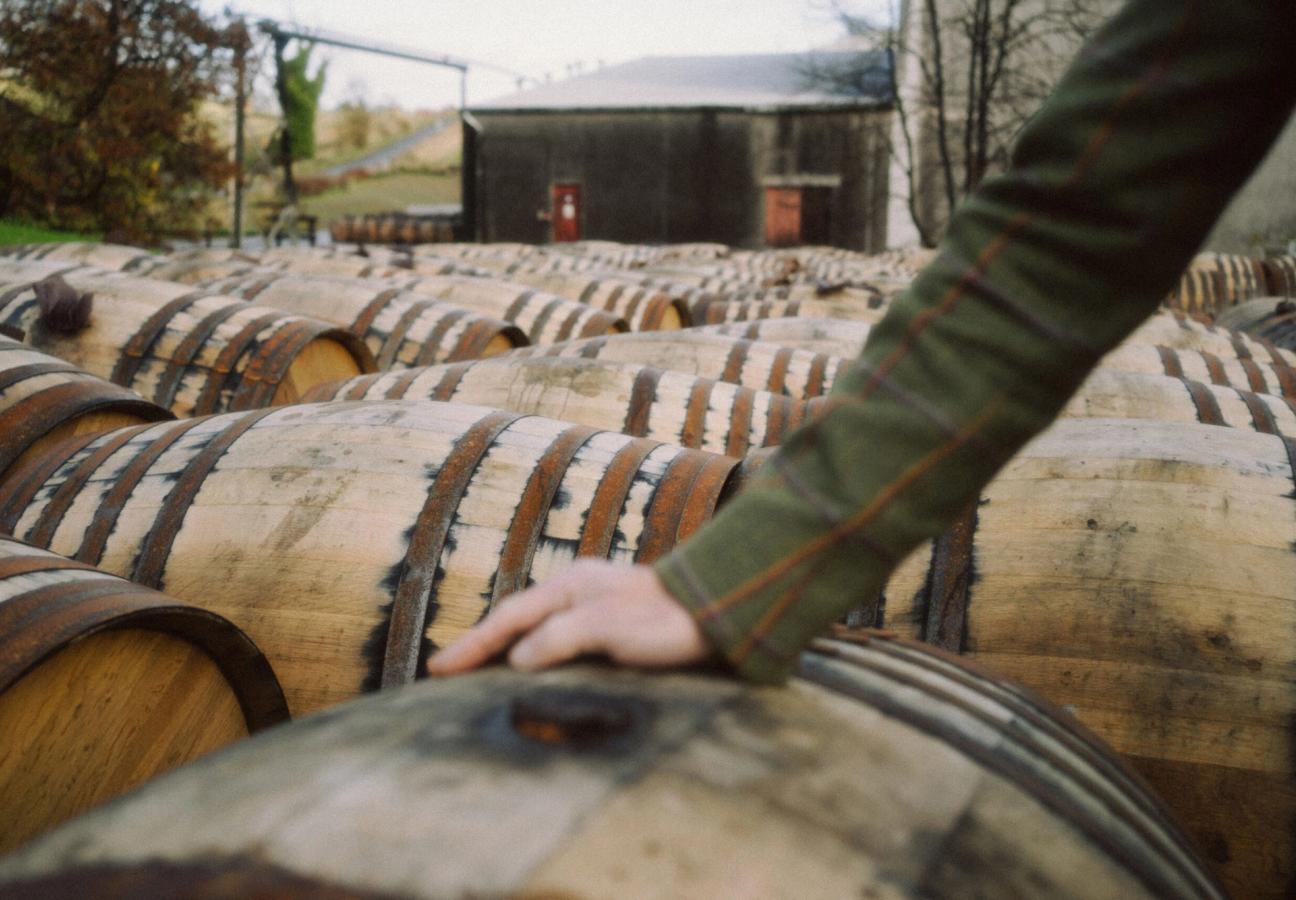

Built on taste and tradition, The GlenDronach knows the way of whisky
We travel to Aberdeenshire, to discover a distillery brimming with a history of fine craftsmanship and award-winning whisky…
If you’re looking for a window onto the world of heritage-heavy whiskymaking, The GlenDronach Distillery is a good place to start. Come to think of it, if you’re just looking for windows in general, the Highland distillery is still worth a trip. For, at the front of the vast main building, a bank of soaring, panoramic windows offer a windswept vista out over the wilds of Aberdeenshire. It’s quite the view.
And it’s a view that goes both ways. For, if you stand outside the distillery and look back inside, you’ll see a brigade of four handsome copper stills sitting pretty in the listed building, uplit and hard at whisky-making work. Earlier today, we got a closer look at the striking stills, and Stewart Buchanan, The GlenDronach’s tartan-trimmed brand ambassador, explained how their sculpted shapes influence the whisky’s flavour.
In the gooseneck, Buchanan explained — that ’saxophone’ shape — the vapours take on oilier, spicier scents, those of leather, library books, cedar and cigar boxes. Whereas, down in the ‘belly’ of the beast, the dome teases out rounder notes, of autumnal berries and fruits.
“And all of these notes,” the ambassador added, “you’ll also find in sherry casks. They’re in perfect synergy with those casks, and that’s why they’re the casks we’ve always used. This whisky enjoys being in those casks”.
But we’re getting ahead of ourselves. Because this whisky lives plenty of barley-steeping, kiln-drying life before it hits the cask — and The GlenDronach distillery has had many lives, rebirths and resurgences itself. Its first founding, in 1826, saw the distillery become one of the first licensed in Scotland. In 1830, Walter Scott of the Teaninich Distillery bought the place and, by the 1860s, The GlenDronach was the largest duty paying distillery in the Scottish Highlands.

In a small courtyard, tucked away in the heart of the distillery, there are flaking red window frames, mossy cobbles and an antique delivery cart, with ‘The GlenDronach Disty Co. Ltd.’ charmingly emblazoned down its side. On the walls, you’ll find stones set into the wall commemorating key individuals in the brand’s history. Walter Scott is one. And, a few bricks over, Captain Charles Grant — the son of the Glenfiddich Distillery founder and the black sheep of that hallowed whisky-making clan. In 1920, Grant bought The GlenDronach, and put his own stamp on the spirit. Forty years later, another whisky dynasty took the reins; Teacher’s, who doubled the number of stills from two to the four visible through that vast window today.
During the whisky boom of the 1960s and 1970s, The GlenDronach kept its heritage-heavy head down and, by 1996, the distillery was mothballed for six short years. In 2002, production started up once again and, come 2005, Chivas Brothers took over. A cèilidh of alternating ownership danced The GlenDronach through the next decade and, in 2016, current owners Brown-Forman took over, appointing Dr. Rachel Barrie as the Master Blender.
But visit today, and you wouldn’t guess at the upheavals and unrest of The GlenDronach’s past. There’s no turbulence on show here; just tranquility. The distillery is a quiet, mostly manual presence perched among Aberdeenshire’s rolling hills. Restful and remote — “It’s not a distillery you pass by accident,” Buchanan notes — it sits seamlessly amidst its natural surroundings, and borrows from these resources to create its whisky.
The ‘Dronac Burn’, a gentle stream, flows through the central courtyard of the distillery and under the main building. Water from here is fed inside to the distillery’s heat exchange — where it is used to pre-heat the would-be whisky before it enters the pot still. The purer, softer Highland water used to create the spirit itself is sourced from further afield, albeit barely. Around half a mile away, up through Gordon Wood (a memorial forest planted for a local army regiment) you’ll find a reservoir — and this is where The GlenDronach finds its precious base water.
Back on distillery grounds, Glen House stands guard on a slight hill. Built in 1771 and allegedly haunted (by the spectre of a Spanish señorita who travelled to Scotland in a sherry cask), the eeriness is only escalated by the scores of ravens soaring and sitting around the place.
“It’s not a distillery you pass by accident…”
Historically, Buchanan reveals, these black-feathered birds would sit around the perimeter of the farm. And, when illicit stills of the past were in operation, they’d act as an alarm system of sorts — making a flap when visitors or inspectors would arrive at odd times.
Their sharp-beaked skills have been immortalised in The GlenDronach’s range of whiskies. ‘Parliament’, the collective name for a group of rooks, is the name of the oldest whisky in the brand’s core collection, a 21-year-old single malt. ‘Allardice’ (paying homage to distillery founder James Allardice) is an 18-year-old expression, with ‘Revival’ the 15-year, and ‘Original’ the 12. There are also special editions, such as the incredible ‘Grandeur’ series, and a ‘Kingsman Edition 1989 Vintage’ created for Matthew Vaughn’s stirring spy franchise. And, whilst all have different notes — cherry blossom, espresso and honeydew melon among them — these whiskies share the same base flavours, influenced by those grand stills and the rich taste of Scottish malted barley.
This barley begins its GlenDronach journey in a mash tun. In the main distillery building, the distinctive cast iron tun is topped with a copper dome, and was first put into service in 1967. There are only 14 similar set-ups left in Scotland and, as Buchanan explains, “it’s basically a big cafetière”. It gleams, with its decades-old rivets still proudly shining. This comes down to constant care, frequent polishing — and the inimitable human touch.
There are two men working the distillery at any one time, with shifts covering 24 hours a day. But nothing is automated, Buchanan is quick to clarify. “There may be screens that display temperatures, but it’s not a push-a-button distillery,” says the ambassador. “Sometimes you go into distilleries, and it’s like NASA”.
History and heritage means a lot to the workers here. This was the last coal-fired distillery in Scotland, a tradition that ended in 2005. But losing this technique didn’t affect the flavour of the spirit, says Buchanan; coal-fired doesn’t afford whisky the caramelised, smoky notes you may think. Instead, most of the meatiest flavours come from the casks. But, before the spirit is siphoned off into these barrels, it must spend some time in the washbacks — huge vessels where the liquid ferments. At The GlenDronach, the nine vast washbacks are built from sturdy Scottish Larch, a perfect wood for the job; not too knotty or resinous.

“Each has an 18,000 litre capacity,” says Buchanan. “But only around 1,800 litres of this goes to cask. So we’re still actually quite boutique”.
Those casks, trundled and rolled around the distillery, are the finest Pedro Ximénez and Oloroso sherry casks, sourced from Andalucia in Spain. Delivering depth, complexity and character, they are the final flavourful flourish in an age-old, ever-refined process. But Buchanan is keen to stress the relative small-scale of The GlenDronach’s whisky-making, especially when compared with scotch’s biggest players. And this artisanal touch, he says, lends a weight in its own right; of experience, of exclusivity and of exquisite, traditional taste. “We are,” says the ambassador, “something of a sleeping giant”.
Please Drink Responsibly
GlenDronach is a registered trademark. ©2022 Benriach
Want more spirited tips? These are the best whisky glasses (to do your Scotch justice)…
Become a Gentleman’s Journal member. Find out more here.



